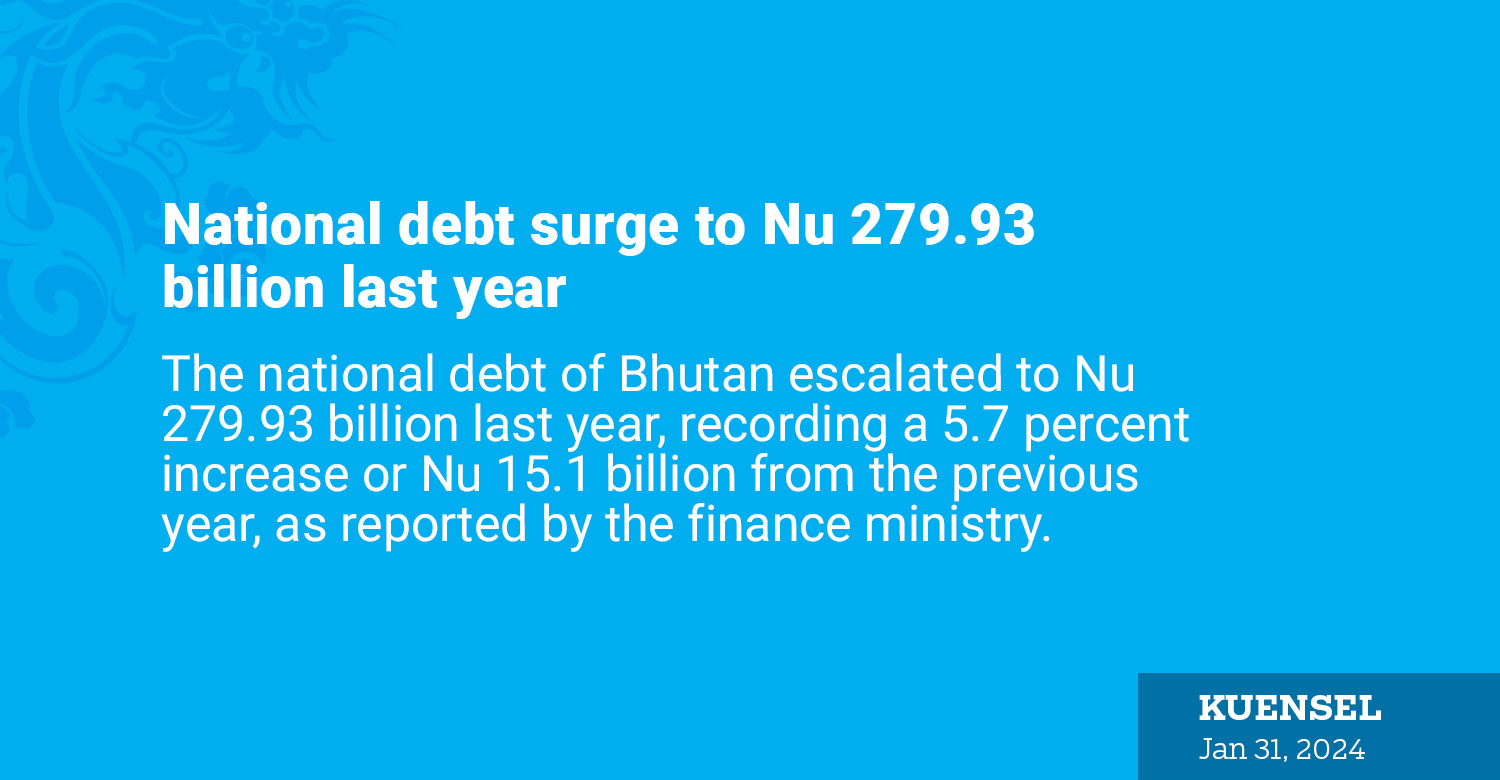… debt to GDP ratio of 200 percent will not be sustainable, economists say
Thukten Zangpo
The national debt of Bhutan escalated to Nu 279.93 billion last year, recording a 5.7 percent increase or Nu 15.1 billion from the previous year, as reported by the finance ministry.
This debt, representing the total amount owed by the government, reached 103.2 percent of the fiscal year 2023-24 gross domestic product (GDP) estimates, which is at Nu 219.51 billion. In share to GDP, it saw a decline from 129.1 percent of GDP in 2022.
The surge in debt was because of the growth in both external and domestic debt. External debt rose to Nu 251.83 billion, witnessing an increase of Nu 14.2 billion from the previous year. At the same time, domestic debt increased slightly to Nu 28.1 billion, with a growth of Nu 900 million during the same period.
Anticipating a further rise with the initiation of the 13th Plan with an estimated budget of Nu 512.48 billion. The capital budget was reported at Nu 250 billion, constituting 49 percent of the total budget.
The government resorts to borrowing funds to bridge the fiscal deficit, where expenditures exceed the revenue generated. For the 13th Plan, the fiscal deficit is estimated at Nu 53.59 billion, accounting for 9 percent of the GDP.
Economists caution that if the country’s debt reaches 200 percent of GDP, it could become unsustainable, leading to a debt servicing burden exceeding 35 percent of domestic revenue.
As of the fiscal year 2023-24, the debt service to domestic revenue was estimated at 25.4 percent, amounting to Nu 14.54 billion, well within the 35 percent threshold outlined in the Public Debt Management Policy 2023.
Should a significant portion of the revenue be allocated to debt servicing, it could limit funds available for public investments, including social and developmental projects, potentially leading to a “debt overhang” situation.
Breaking down last year’s domestic debt of Nu 28.1 billion, it comprised Nu 6 billion in treasury bill and Nu 22.1 billion in government debts.
External debt, owed by the government, corporations, and the central bank, was recorded at Nu 228.98 billion, Nu 12.85 billion in corporate debt and Nu 10 billion in central bank debt owed to the government of India for standby credit facility respectively.
Hydro-debt for six hydropower projects amounted to Nu 167.07 billion, representing 66.3 percent of external debt and 61.6 percent of the fiscal year 2023-24 GDP estimate.
Non-hydro debt was recorded at Nu 84.76 billion, constituting 33.7 percent of external debt and 31.3 percent of the GDP estimate.
INR-denominated debt accounted for 93.8 percent of hydropower debt, amounting to Nu 161.84 billion. Convertible currency debt was USD 1.08 billion or Nu 89.99 billion.
Non-hydro budgetary debt, used for financing budget deficits from both external and domestic sources, was recorded at Nu 94.32 billion, representing 33.7 percent of public debt and 34.8 percent of the estimated GDP. According to the Public Debt Policy 2023, non-hydro budgetary debt should not exceed 55 percent of GDP in any given year.
Sovereign guarantees stood at Nu 4.56 billion, accounting for 1.7 percent of the GDP estimate.
Despite the debt reaching 103.2 percent of GDP, the finance ministry stated that the risk is manageable, with external debt distress being moderate.
This is attributed to 66.3 percent of external debt being in hydropower projects with secured export to India, and 90.9 percent of hydro debt being denominated in INR, mitigating exchange rate risks due to the currency peg.


